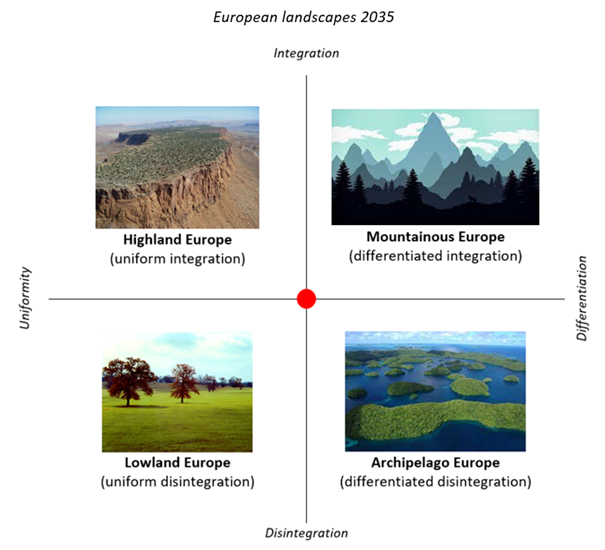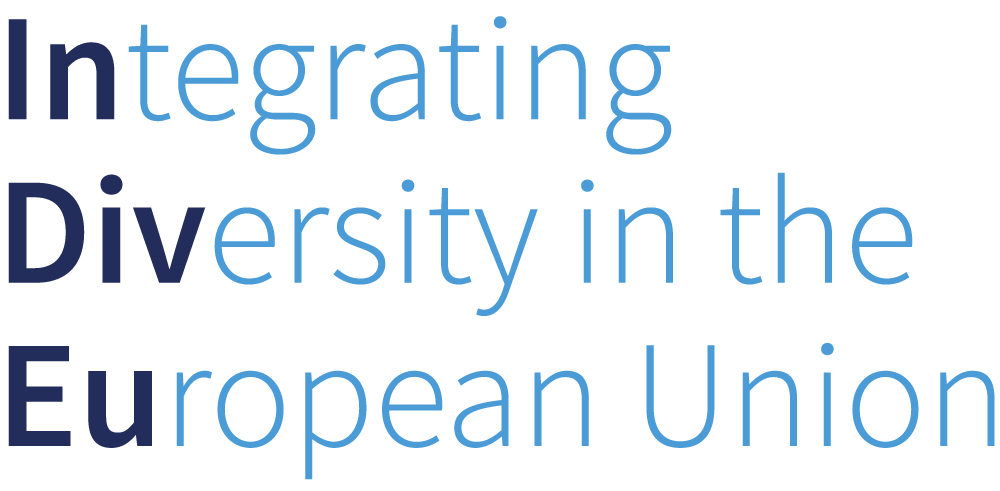Differentiated integration, understood in its internal dimension (internal DI), is a form of European integration allowing for the selective limitation of the validity of international legal rules to a subset of the EU member states. A closely related concept, ‘external’ differentiated integration (external DI), is dealt separately in the section on external differentiation . Differentiated integration is a formal choice in the design of international schemes which seeks to reconcile the promotion of further legal and political integration with the protection of key national interests and preferences. It stands in opposition to a higher level of uniform integration, the status quo, and uniform or differentiated disintegration. Other forms of flexible integration also exist and are outlined in the section on flexible integration.
The second chapter of this manual summarizes the main features of differentiated integration on the basis of a critical review of the available academic literature and empirical evidence: its main forms; its past and present patterns; its causes; its expected outcomes; and proposals and scenarios for its future use.
Forms
Differentiated integration comes in many forms, each exhibiting different features and outcomes. Theoretically, a number of binary or continuous features can be identified, which can be combined to form a variety of types.
First, differentiations can be multi-speed (temporary) or multi-end (permanent). Second, differentiations can lead to a multi-tier pattern (‘core Europe’, ‘concentric circles’) or to a multi-menu pattern (‘à la carte’ integration). Third, existing differentiations are overwhelmingly geared at the promotion of further integration and do not allow the regression from existing integration levels (differentiated integration), but some theoretical proposals argue for their use to enable forms of differentiated disintegration (e.g. the right of unilateral or negotiated withdrawal from specific policy ‘clubs’). Fourth, differentiations may be based on EU law (EU primary, secondary, and tertiary law) or on international law (inter se treaties, international organizations). Fifth, differentiations may be voluntary (when country successfully negotiates a legal opt-out from an unwanted commitment) or involuntary (when new EU member states are subjected to temporary ‘discriminatory’ exceptions or when some EU members are purposely excluded from inter se treaties). Sixth, individual differentiations may encompass a small ‘outsider’ group (e.g. the Schengen area) or a large one (e.g. the Euro area). Seventh, differentiations rarely involve a full opt-out from an entire legal instrument or policy area (e.g. the Danish opt-out from the Economic and Monetary Union) and typically foresee instead a selective opt-out from specific legal provisions. Finally, formal differentiation is not always matched by material differentiation, that is exemptions from the actual pooling of funds and resources. For instance, countries with major formal differentiations in key policy areas (e.g. Denmark and Ireland) often seek to selectively ‘reintegrate’ in them with subsequent agreements, ending up as participants and funders of many relevant EU agencies and programmes.
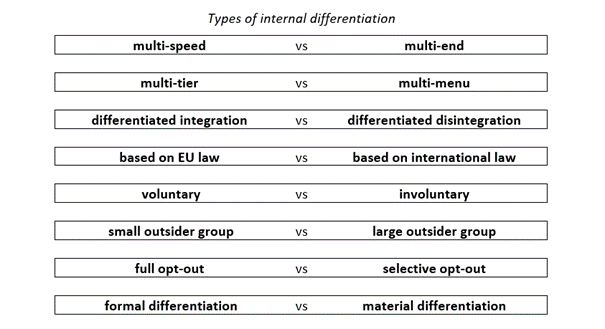
In practice, the choice of the legal tool strongly constrains the feasibility and potential impact of differentiations. Primary EU law is very difficult to introduce and change, requiring the unanimous consent of all national governments and complex negotiation and ratification procedures, but is often the only viable option to promote further integration in areas lying outside existing EU competences and to introduce exemptions which would clash with existing Treaty obligations. Differentiations in this area include both full opt-outs from entire policy areas and more selective exemptions from individual articles and provisions. Secondary EU law is easier to introduce and change, often requiring only a qualified majority vote (QMV) of all national governments or of the national governments participating in the specific ‘club’, but it must be compatible with existing EU Treaties. A number of alternative tools are available, including ‘normal’ (ordinary and special) legislative procedures, the general enhanced cooperation procedure, and special differentiated regimes in the field of the Economic Monetary Union (EMU), the Area of Freedom, Security and Justice (AFSJ), and security and defence policy (PESCO). Finally, treaties under international law are typically easier to negotiate, are not restricted by the scope of EU competences, and allow for the self-selection of participants, but must be compatible with existing EU law, do not enjoy the advantages of EU legislation (tested negotiating fora, primary and direct effect, use of EU budget and institutions), and are disliked by strongly Europhile actors for their detrimental impact on the EU legal order and on European solidarity. They include both bilateral inter se treaties, multilateral inter se treaties, and other international treaties and organizations including non-EU members (e.g. Council of Europe conventions, North Atlantic Treaty Organization).

Patterns
The empirical patterns assumed by differentiated integration in the history of European integration can be tracked with great precision with the help of quantitative datasets. This tells us that differentiation has been and remains a common feature of the European Union, albeit its prevalence has varied over time and is less frequent that what might be expected. Differentiation in three kinds of legal tools (primary EU law, secondary EU law, international law) must be analysed separately, due to the way the empirical evidence has been collected and coded.
Differentiation in primary EU law has sporadically been present since the entry into force of the European Coal and Steel Community (ECSC) Treaty in 1952 but only took off after the entry into force of the Maastricht Treaty (TUE) in 1993. According to the EUDIFF1 dataset , which includes not only EU Treaties and Accession Treaties but also six EU-related inter se agreements, it has affected 13.3 per cent of Treaty articles and 4.6 per cent of opportunities across the 1952–2020 period. In 2020, this touched 34.4 per cent of articles (388 out of 1,127) and only 4.6 per cent of opportunities, markedly below the peak of 11.3 per cent reached in 2006. The figures include both the consequences of major opt-outs permanently exempting individual countries from an entire policy area (currently, six opt-outs for Denmark, Ireland, and Poland) and more specific and temporary exemptions to individual articles.
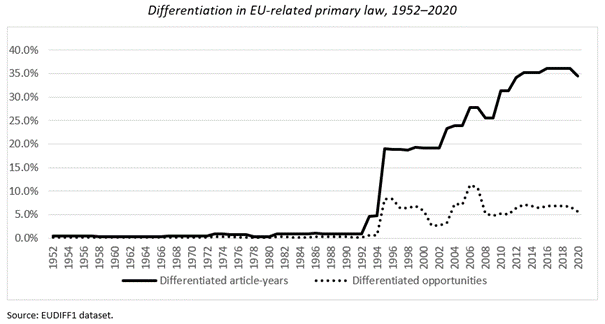
Differentiation in secondary EU law has been more constant over time. According to the EUDIFF2 dataset, it has affected 11.2 per cent of legislative acts and 2.0 per cent of opportunities across the 1958–2018 period. In 2018, this touched 14.4 per cent of acts (204 out of 1,414) and 2.6 per cent of opportunities, with a slow increase since the trough of 1.2 per cent reached in 2008. The figures include both full exemptions from an entire act (e.g. as a consequence of Treaty opt-outs) and selective exceptions or qualifications on individual norms.

Differentiation in international law, outside of EU law, has yet to be properly quantified but includes a large number of bilateral inter se treaties (such as the 1964 Élisée Treaty between France and West Germany), multilateral inter se treaties (such as the 2001 OCCAR Convention), other international treaties and organizations (such as the 1949 North Atlantic Treaty Organization), and informal agreements. According to the United Nations Treaty Collection , an individual EU member state is typically party of slightly less than a thousand international treaties, almost equally divided between bilateral and multilateral ones: some of them lead to more or less important differentiation effects. Crucially, inter se treaties and informal agreements have frequently been used in the history of European integration as tools to launch ambitious integration efforts among a ‘vanguard group’ of countries: important examples are the 1948 Western European Union, the 1979 European Monetary System, the 1985 Schengen Agreement, the 2000 Charter of Fundamental Rights of the European Union, the 2012 Treaty establishing the European Stability Mechanism, and the 2013 Fiscal Compact. In many of these cases, the content of the international agreement has been partially of fully ‘repatriated’ within EU law at a later stage, preserving the existing differentiations but overcoming resistances to the use of EU legal instruments (EU Treaties and secondary legislation). The EUDIFF2 dataset can also be used to map the prevalence of differentiated integration across member states and policy areas as well as its temporary or permanent character. In term of affected member states, differentiations affect all countries but are high only in a handful of them: Denmark, the United Kingdom, Ireland, and Cyprus. In term of affected policy areas, differentiations predominantly affect politically sensitive domains belonging to the ‘core state powers’, such as immigration, monetary policy, and taxation, but are also common in some ‘low politics’ areas such as research, the single market, and social cohesion. In terms of permanence over time, differentiation seem to be predominantly of a multi-speed type: over the whole 1958–2018 period, only a minority of differentiations have turned out to be permanent (45.0 per cent) while the rest have been conceived from the outset as temporary (19.6 per cent) or have nevertheless expired (35.3 per cent). However, the figures certainly overestimate the share of the former, as many recent differentiations are likely to expire in due course.
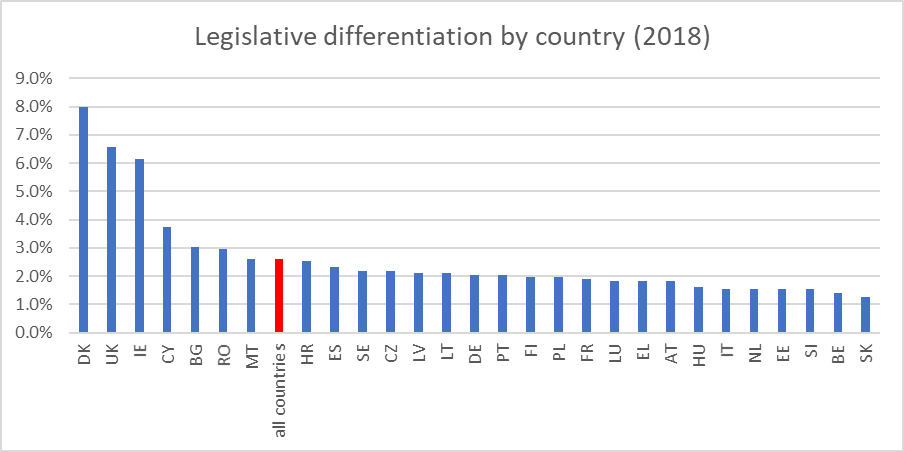
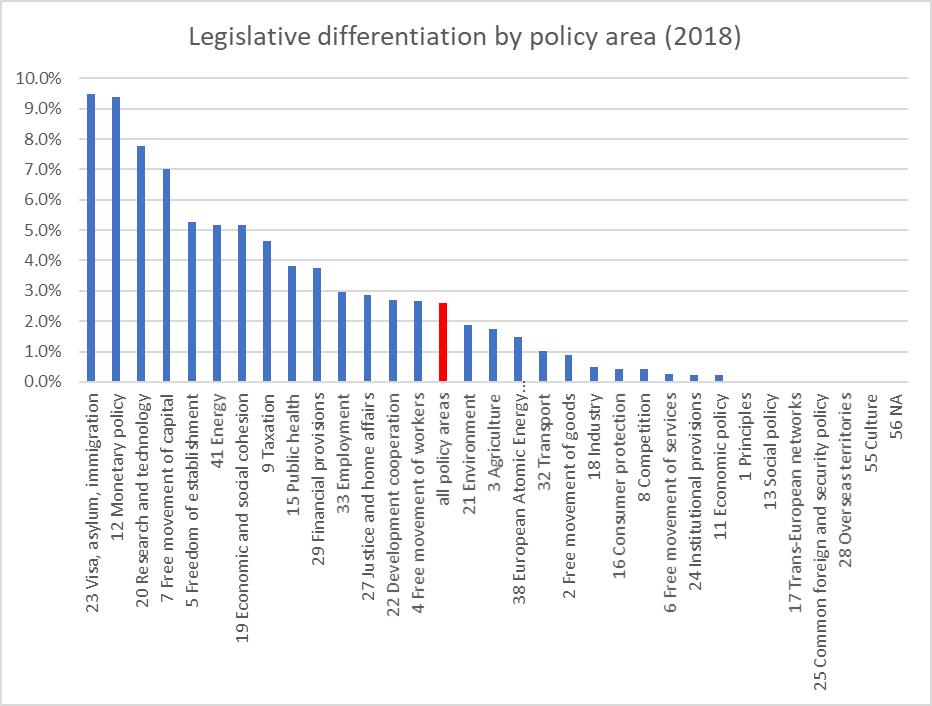
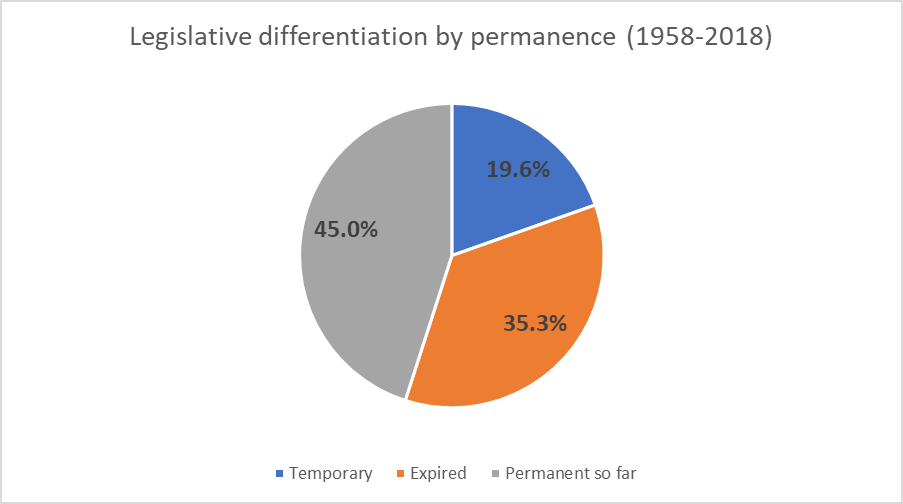
Altogether, differentiation has generally been deployed in an eclectic, pragmatic, and constrained manner which might be termed reluctant differentiation. In terms of purpose, it has almost exclusively been used to promote further integration, while proposals advocating differentiated disintegration have remained largely theoretical. In terms of persistence, it is more multi-speed (temporary) than multi-end (permanent). In terms of morphology, it has fully matched the expectations of neither a multi-tier nor a multi-menu model, giving rise instead to a ‘soft-core Europe’ of partially overlapping policy regimes and fine-grained exceptions. Finally, most differentiations have only been granted as an option of last resort, are highly constrained in scope, and are very controversial, due to a fear of their effect on the uniformity of EU law, the stringency of shared commitments, and European identity and solidarity. Whereas differentiation is often the norm in international relations (e.g. principle of free consent, unilateral reservations) and many multilateral organizations (e.g. United Nations and Council of Europe conventions), legal and political integration within the European Union remains largely uniform.
Nevertheless, differentiation is likely to continue to play an important role in the future of European integration. First, as the growing number and heterogeneity of EU member states under unanimity decision-making rules continually brings the EU to the brink of political paralysis, differentiated integration (its actual use as well as its mere threat) represents a useful tool to rein in or bypass isolated resistances to further integration. Secondly, further integration in currently differentiated policy areas and in core state powers are likely to create new permanent differentiations, although the stagnation of the process of EU enlargement is likely to reduce the number of temporary differentiations. Thirdly, currently differentiated regimes do exhibit a certain tendency to expand their membership over time, but none of them (particularly the Economic and Monetary Union) is expected to reach complete uniformity in the foreseeable future. At the same time, many of the current challenges facing the European Union centre on constitutional, redistributive policies, and regulatory policies where differentiated integration may be functionally suboptimal and normatively controversial. Over the past decade, the Eurozone crisis has produced a marked increase of differentiated integration, but the migration crisis has resulted in no further integration, and the Brexit and Covid-19 crisis have let to a renewed focus on uniform integration. Thus, much of the future evolution will depend on the contingent outcome of general and policy-specific debates among national governments and European institutions.
Causes
Many competing insights and theories have been proposed to explain why the desire of EU member states to cooperate in a specific policy area leads to differentiated integration, rather than to uniform integration or the maintenance of the status quo.
In a comprehensive synthesis, Schimmelfennig and Winzen have identified ten demand and supply factors as the main drivers of differentiated integration. Subsequent preliminary testing seems to partially support the expectations of the model, albeit with several caveats. The sources of heterogeneity have an unexpectedly uneven impact: a strong exclusive national identity tends to increase the likelihood of differentiations for a country, but the impact of a high relative wealth depends on the context (slightly positive for old member states, strongly negative for new member states), and a large country size in terms of population or Gross Domestic Product has no significant impact. The policy contextplays an important role, as differentiation overwhelmingly occurs in the politically sensitive broad area of core state powers (in the form of ‘constitutional’ differentiations motivated by national sovereignty and identity concerns), but this impact is uneven across legal tools: in accession treaties and secondary EU law, differentiation also frequently occurs in areas theoretically resistant to differentiated integration such as the internal market (in the form of ‘instrumental’ or discriminatory differentiation motivated by efficiency and distributional concerns). The impact of actual heterogeneity (preferences, dependence, and capacity) and of supply factors has not been tested directly, as it would require a detailed analysis of the conditions and outcomes of potential reforms proposals, rather than successful integration agreements. The fact that new differentiations in each amendment of primary and secondary EU law typically concern only a small minority of countries, however, lends some support to the hypothesis that a large group of insiders and low negative externalities for outsiders may be conducive to differentiated integration.Similarly, the fact that actual differentiations are concentrated in the integration of new policies and new members and in already differentiated policy areas also seems to support the idea of a strong role of played by the institutional context, as the pressure exerted by majoritarian decision-making mechanisms, shared norms, and supranational actors in favour of uniform integration is here stronger than in more established areas of cooperation (e.g. the Single Market).
In addition, the analysis of empirical patterns clearly shows that the amount of differentiation strongly depends on the pace of deepening and widening of European integration. Whenever integration moves forward, overall differentiation tends to rise to accommodate or bypass national resistances; in phases of stagnation, on the contrary, overall differentiation tends to decrease, as part of the existing exemptions expire and are not replaced by new ones.
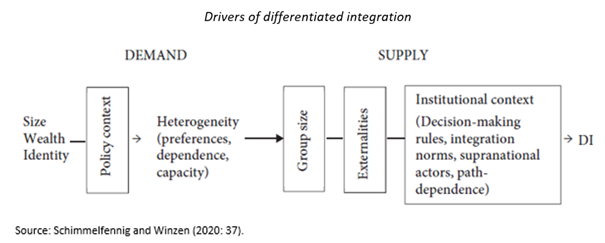
Altogether, these factors explain some but not all instances of differentiation, which often seems to depend on a delicate combination of factors strongly dependent on contextual, contingent, and random variations, such as: fine-grained subjective expectations about the likely outcomes of a specific norm; the politicization of the issue at stake among specific national veto players and electorates; the need of, or decision to, ratify the decision via constitutional amendments and popular referendums; and a failure to negotiate uniform commitments through package deals, compensatory payments, or diplomatic pressures.
Outcomes
Differentiated integration produces markedly different outcomes than its main alternatives: uniform integration and no further integration (the status quo).
In political terms, differentiated integration offers a way to tailor the degree of European integration of each country to its national interests, preferences, and capacities: vanguard countries are allowed to move forward with common schemes without the need of getting the consent of every other member state and laggard countries are not forced to adopt commitments adversely impacting on their preferences and autonomy. Thus, differentiated integration may increase the degree of subjective desirability and acceptance of a given scheme at the national level. At the same time, it may produce several undesirable side effects. Firstly, differentiated integration may reduce the satisfaction of aggregate supranational preferences, if other countries strongly object to the formation of vanguard groups and to the granting of opt-outs. Secondly, individual states may be encouraged to adopt a ‘cherry-picking’approach, pursuing the benefits of cooperation but avoiding its inevitable costs. The final result is a patchwork of underwhelming and inefficient agreements, as ‘package deals’ allowing negotiations across policy issues are made more difficult, frequent opt-outs reduce the benefits of policies requiring a large and uniform participation (the single market, redistributive schemes, the production of common goods exposed to free-riding), and the system becomes more complex and costly (separate decision-making and implementing bodies, proliferation of legal and administrative requirements). Thirdly, differentiated integration may undermine the sense of common identity and solidarity among the member states of the EU. As a consequence, this option is highly controversial within the European Union and always faces a large degree of principled and pragmatic opposition. Finally, it typically allows only for a one-off, binary in-out choice in the context of the introduction or renegotiation of specific legal instruments, while differentiated disintegration (e.g. the unilateral or negotiated right to rescind specific commitments) and other forms of flexibility (e.g. loose and non-binding commitments, legislative and administrative discretion, experimentalist governance, non-compliance) offer the possibility of a more nuanced graduation of integration levels.
In practical terms, differentiation has an important impact on the subsequent course of European integration. On the one hand, it is often a necessary precondition for further integration: without the possibility for countries to opt out from new initiatives or to be granted selective exceptions, negotiations subject to the unanimous consent of all EU member states are more likely to result in no integration and the continuation of the status quo. On the other hand, differentiation frequently produces a strong path dependence: major Treaty opt-outs automatically reverberate on subsequent secondary legislation; countries and policy areas with pre-existing differentiations are more likely to acquire new differentiations as time goes by; and countries with a history of differentiations tend to view more positively both existing exceptions (e.g. non-membership in the Euro area) and differentiated integration in general. Finally, some authors have hypothesised that differentiations may encourage disintegration and reduce non-compliance, but neither claim seem to be borne out by the empirical evidence.
Proposals and scenarios
The use of differentiation as a tool to enable further integration of the EU while accommodating an increased heterogeneity among its member states has long been of interest to policymakers, practitioners, and academics. Since at least the 1970s, prominent politicians such as Leo Tindemans, Ralf Dahrendorf, Jacques Delors, Wolfgang Schäuble, David Cameron, and Emmanuel Macron have advocated specific forms of differentiated integration as the way forward for the European integration process. This interest has reached a high point in the 2010s, when the apparent inability of the EU to address vital challenges and concerns led to a flurry of projects of reform, many of which included a strong differentiation component.
A representative summary of recent proposals for the future use of differentiation is provided in the figure below. All proposals include multi-speed elements (countries are typically allowed to give up their opt-outs and join the integrated group at a later date) but present major differences in terms of their main type of differentiation (multi-tier, multi-menu, or incremental), their impact on the EU legal order (unitary, dual but compatible, or dual) and institutions (unitary, differentiated, or separate), the number of policy clubs foreseen (fixed or open), the right to scale back existing commitments (not allowed, allowed once, or allowed), and the need for a preliminary reform of the EU Treaties (required or not). A first group of proposals, which can be termed incremental integration, views differentiation as an effective means to promote further integration without altering the existing membership and opt-outs of the EU. From this perspective, specific vanguard groups should move forward with differentiated integration schemes in key policy areas, bypassing the resistance of laggard countries. Some proposals can be implemented within the current legal framework, for instance through the use of existing differentiated regimes or new enhanced cooperations, while others would require a reform of the Treaties and the explicit consent of all member states. A second group of proposals, which can be termed multi-tier integration, advocates a radical restructuring of the EU in two clearly distinct entities: a highly integrated core and a less integrated periphery. This could happen either through an additional inter se treaty among the core countries or through a Treaty reform allowing a ‘decoupling’ of core and periphery. A third group of proposals, which can be termed multi-menu (dis)integration, advocates a reform of the Treaties to expand the possibility to adjust the actual level of integration of individual countries, formalizing the existence of specific policy ‘clubs’ and allowing for a (unilateral or negotiated) entry in and exit from them. Crucially, this perspective explicitly permits a regression of existing levels of integration: if countries are interested in cooperating, it will result in differentiated integration; if not, it will lead to differentiated disintegration. Altogether, this review shows the versatility of differentiation, as its concrete design choices can be inspired by opposing preoccupations and can lead to widely different empirical outcomes. Despite their theoretical appeal, most proposals are unlikely to ever find a concrete application in their entirety, as path dependency, legal obstacles, decision-making mechanisms with many veto players, and dominant political preferences converge to resist radical departures from the status quo and favour a course of modest, incremental integration without major Treaty changes. However, multi-speed, multi-menu, and multi-tier elements will necessarily represent more or less prominent components of such incremental process, shaping its direction, pace, and characteristics.

The possible impact of differentiation on the future course of European integration can be usefully explored with the help of scenarios: challenging, plausible, and memorable depictions of ‘possible futures’ which visualize their main expected outcomes and stimulate an informed debate about desirable visions, threats, opportunities, strategic choices, and appropriate institutional, legal, and policy solutions. To this end, the InDivEU project has developed European landscapes 2035, a set of four narrative scenarios on internal differentiation outlining the possible consequences of different strategic choices on the future of the European Union by 2035. The scenarios are based on an in-depth analysis of the relevant scientific literature and empirical evidence, presented in a narrative style, and depict four possible evolutions of the status quo (red dot): uniform integration (Highland Europe), differentiated integration (Mountainous Europe), uniform disintegration (Lowland Europe), and differentiated disintegration (Archipelago Europe). While reflecting existing knowledge on the likely outcomes, strengths, and weaknesses of each option, they all depict relatively successful situations in an unbiased manner, leaving each reader free to autonomously assess their desirability according to his or her own specific values, preferences, and sensibilities. The text of the four scenarios can be read in the following policy paper.
